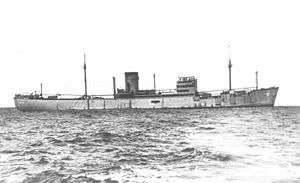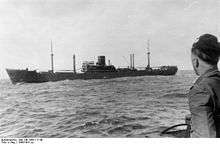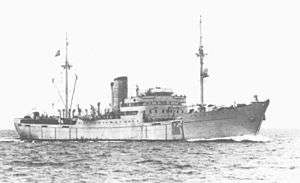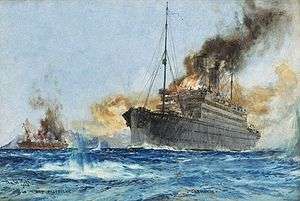This is a dynamic list and may never be able to satisfy particular standards for completeness. You can help by expanding it with reliably sourced entries.
The following is a list, by period and country, of armed merchant ships used since late 19th century in the role of auxiliary cruisers, also called armed merchant cruisers.
Ships by period
Spanish-American War
American auxiliary cruisers
Russo-Japanese War
Japanese merchant cruisers
| Name |
Comment |
| America Maru | |
| Bingo Maru | |
| Hong Kong Maru | |
| Kasuga Maru | |
| Kumano Maru | |
| Nikko Maru | |
| Nippon Maru | |
| Saikyo Maru | |
| Shinano Maru | |
| Taichu Maru | |
| Tainan Maru | |
| Yobo | (ex-Yobo Maru) |
Russian merchant cruisers
Note: This listing is incomplete.
| Name |
Comment |
| Zabiaka | |
| Lena | |
| Ural | |
World War I
Allied merchant cruisers
This is a dynamic list and may never be able to satisfy particular standards for completeness. You can help by expanding it with reliably sourced entries.
Royal Navy
| Name |
Notes |
| Alcantara | Lost on 29 February 1916. |
| Almanzora | In service 23Aug.15-20.Dec.19. 1 of over 60 commissioned AMC's employed on patrol and later convoy protection, 33 served with 10th Cruiser Squadron on Northern Patrol. |
| Alsatian | Post war, Allan line was taken over by CP and SS Alsatian was named RMS Empress of France 4 April 1919. |
| Ambrose | Became depot ship October 1915.[1] |
| Andes | |
| Aquitania | |
| Arlanza | |
| Aramadale Castle | |
| Avenger | Ex-Aotearoa, torpedoed and lost on 14 June 1917. |
| Avoca | |
| Bayano | Lost on 11 March 1915 off Carswell Point, Stranraer - sunk by U-27.[2] |
| Berrida | |
| Calgarian | Lost on 1 March 1918. |
| Calyx | Ex-Calypso, lost 10 July 1916.[1] |
| Candidate | Torpedoed 6 May 1915, sunk by U-20 |
| Caribbean | Became accommodation ship July 1915, foundered 26 September 1915.[1] |
| Carmania | Victor of the Battle of Trindade, served at Gallipoli and thereafter as a troopship, returned to civilian service by 1919. |
| Caronia | |
| Cedric | |
| Celtic | |
| Centurion | Torpedoed 6 May 1915, sunk by U-20 |
| Changuinola | |
| City of London | |
| Clan MacNaughton | Lost on 3 February 1915. |
| Columbella | Ex-Columbia, Anchor Line. |
| Digby | Transferred to French Navy as Artois on 24 November 1915, renamed Digby July 1917. |
| Ebro | |
| Edinburgh Castle | |
| Empress of Asia | |
| Empress of Britain | |
| Empress of Japan | |
| Empress of Russia | Requisitioned 1914, released to civilian service October 1915, re-requisitioned 1918 until 1919. |
| Eskimo | Returned from Navy July 1915, Captured 26 July 1916.[1] |
| Gloucestershire | |
| Hilary | Lost on 25 May 1917, sunk by U-88. |
| Hildebrand | |
| Himalaya | |
| India | Lost on 8 August 1915. |
| Kildonan Castle | |
| Kinfauns Castle | |
| Laconia | Lost on 25 February 1917, sunk by U-50. |
| Laurentic | Lost on 23 January 1917. |
| Lusitania | Although on the list of the British Admiralty's AMCs, it never performed in this role, and remained in civilian use. Lost 7 May 1915, sunk by U-20. Sister ship of RMS Mauretania, also on this list. |
| Macedonia | |
| Mantua | |
| Marmora | Lost on 23 July 1918. |
| Mauretania | Sister ship of RMS Lusitania, also on this list. |
| Moldavia | Lost on 23 May 1918. |
| Montezuma | Lost on 25 July 1917, sunk by UC-41.[3] |
| Morea | |
| Motagua | |
| Mount Temple | Lost on 6 December 1916, sunk by Möwe. |
| Naldera | |
| Narkunda | Was serving as an auxiliary transport during the Allied landings in French North Africa in November, 1942. She had disembarked her troops at Bougie and had turned about for home when, toward evening on the 14th, she was bombed and sunk some distance off Bougie. Thirty-one persons were killed. Capt. Parfitt was among the survivors.[4] |
| Oceanic | Lost on 8 September 1914, ran aground. RMS Oceanic was one of the rescue vessels that retrieved bodies from the sinking of the RMS Titanic in 1912. |
| Olympic | Sunk U-103 on 12 May 1918, the only known incident in World War I in which a merchant vessel sank an enemy warship. |
| Ophir | Converted to Hospital Ship in 1918. Returned to the owners in 1919 but never refitted, being broken up in 1922. |
| Orama | Lost on 19 October 1917. |
| Orbita | Also served in the Second World War as a troop carrier from 1941 to 1946. |
| Orcoma | |
| Orduna |
| Oropesa | Transferred to France as Champagne on 2 December 1915. Renamed as Oropesa in July 1917. |
| Orotava | |
| Orvieto | |
| Osiris | |
| Otranto | Survived the Battle of Coronel, stranded on Islay after a collision with the steamship SS Kashmir on 6 October 1918. |
| Otway | Lost on 23 July 1917 torpedoed by German submarine UC 49. |
| Patia | Lost on 13 June 1918. |
| Patnea | |
| Patuca | |
| Princess | Ex-Kronprincess Cecilie; Acted as dummy battleship HMS Ajax.[5] |
| Scotia | |
| Teutonic | Commissioned into the 10th Cruiser Squadron. In 1916, she was refitted with 6-inch guns, and served as a convoy escort ship as well as being used for troop transport. |
| Victorian | |
| Viknor | Ex-RMS Atrato (1888–1912), RMS Viking (1912–1914). Lost on 13 January 1915 off Tory Island. |
| Virginian | |
Royal Australian Navy
| Name |
Comment |
| Berrima | Became Troop Carrier, October 1914. |
|
French Navy
| Name |
Comment |
| Artois | Ex-Royal Navy Digby. |
| Champagne | Ex-Royal Navy Oropesa, lost on 9 October 1917. |
German auxiliary cruisers
Spanish Civil War
The Spanish Nationalists, whose navy was substantially outnumbered by the Republicans, made an extensive use of auxiliary cruisers during the Spanish civil war, two of them on loan from Italy:
| Name |
Comment |
| Mar Cantábrico | Formerly under Republican control, she was captured by the Nationalist cruiser Canarias on 8 March 1937 off Santander. Assisted by the minelayer Vulcano, she took the largest foreign prize of the war with the capture of the Greek steamer Victoria, of 6,600 long tons (6,700 t), on 16 May 1938.[6] |
| Mar Negro | Under Republican flag at the beginning of the war, her captain and crew changed loyalties off Bone, Algeria, while returning to Barcelona from the Soviet Union.[6] She seized the last cargo ship captured during the civil war, the British Stangate off Valencia on 16 March 1939, despite the opposition of HMS Sussex.[7][8] |
| Ciudad de Valencia | She used the alias Nadir for operations in the North Sea. She sank the Republican merchantman SS Cantabria off Cromer, Norfolk, on 2 November 1938.[9] The Republican steamers Josiña and Guernica were forced to seek shelter in Norwegian and Swedish waters, where the latter ran aground on 19 November at the island of Nidingen, in the Kattegat. Josiña reached Kristiansand, and she remained interned there until 1939.[10][11] |
| Ciudad de Alicante | She supported the Ciudad de Valencia in the North Sea, where she played a secondary role in the capture of the Republican steamers Sil and Río Miera. Ciudad de Alicante and Ciudad de Valencia used the German port of Lunden as a resupply base.[10] |
| Ciudad de Palma | Converted to a warship in Italy in 1936. She assisted the minelayer Júpiter in the capture of the British cargo ship Candlestone Castle in Biscay on 17 July 1937. |
| Ciudad de Mahón | |
| Vicente Puchol | After an initial deployment as an improvised minelayer, she was later converted to an auxiliary cruiser. She seized the 1,743 ton freighter Pomaron on 21 February 1938. The ship was the property of Strubin & Co. of London, and was sailing under Estonian flag. She was confiscated and placed under Spanish flag as Castillo Butrón.[12] |
| Antonio Lázaro | After an initial deployment as an improvised minelayer, she was later converted to an auxiliary cruiser. The British liner Llandovery Castle was badly damaged when she struck a mine laid by Lázaro off Cap de Creus on 25 February 1937.[13] |
| Domine | Active as auxiliary cruiser in the bay of Biscay from September to December 1936. Converted into a fast transport to carry allied moor pilgrims to Mecca in January 1937, she was later deployed in the Mediterranean as supply ship.[14] |
| Mallorca | |
| Italian Barletta | Renamed Rio during operations in the Spanish war. She captured the Greek tanker Burlington (under British flag) in the central Mediterranean in 1937. Attacked in Palma de Mallorca by Republican bombers on 26 May 1937. After carrying out four missions, she was disarmed and used as supply ship by Nationalist forces before being returned to Italy. She saw service also during WWII under Italian flag. |
| Italian Adriatico | Renamed Lago during operations in the Spanish war. After three unsuccessful missions, she was disarmed and used as supply ship by Nationalist forces before being returned to Italy. She saw service also during WWII under Italian flag. Sunk by light cruiser HMS Aurora off Cape Bon on 1 December 1941. |
World War II
Allied merchant cruisers
The Armed merchant cruisers were made by requisitioning large ships and providing them with guns and other equipment. They ranged from 6,000–22,000 long tons (6,100–22,400 t). The armament varied but six 6 in (150 mm) guns with 3 in (76 mm) guns as secondary was usual. From 1941, many served as troopships.
| Name |
Comment |
| Alaunia | |
| Alcantara | |
| Andania | Lost, 16 June 1940, sunk by German submarine U-A. |
| Antenor | |
| Antonia | |
| Arawa | |
| Ascania | |
| Asturias | |
| Aurania | |
| Ausonia | |
| Bulolo | |
| California | |
| Canton | |
| Carinthia | Lost, 6 June 1940, sunk by U-46 west of Ireland. |
| Carnarvon Castle | |
| Casanare | Sunk 3 November 1940 along with HMS Patroclus and HMS Laurentic by U-99. |
| Carthage | |
| Cathay | |
| Cheshire | |
| Chitral | |
| Cilicia | |
| Circassia | |
| Comorin | Lost on 6 April 1941. Her burnt out wreck was sunk by HMS Broke. |
| Corfu | |
| Derbyshire | |
| Duchess of Richmond | |
| Duchess of York | |
| Dunnottar Castle | |
| Dunvegan Castle | Lost on 27 August 1940, sunk by U-46 west of Ireland. |
| Empress of Asia | Lost on 5 February 1942. |
| Empress of Australia | |
| Empress of Britain | Lost on 28 October 1940. |
| Empress of Canada | |
| Empress of Japan | |
| Empress of Russia | |
| Empress of Scotland | |
| Esperance Bay | |
| Forfar | sunk by U-99 on 2 December 1940. |
| Hector | Was decommissioned when lost on 5 April 1942 during the Japanese Indian Ocean raid. |
| Jervis Bay | Lost on 5 November 1940 in an engagement against the German cruiser Admiral Scheer. Her commander, Captain Fegen, was awarded a posthumous Victoria Cross. |
| Kanimbla | Transferred to the Royal Australian Navy as a Landing Ship Infantry in 1943 |
| Laconia | |
| Laurentic | Lost on 3 November 1940, sunk by U-99 west of Ireland. |
| Letitia | |
| Maloja | |
| Montclare | |
| Mooltan | |
| Moreton Bay | |
| Patroclus | Lost on 4 November 1940, sunk by U-99 west of Ireland. |
| Pretoria Castle | Converted into an escort carrier as HMS Pretoria Castle. |
| Queen of Bermuda | |
| Rajputana | Lost on 13 April 1941, sunk by U-108 west of Ireland. |
| Ranchi | |
| Ranpura | |
| Rawalpindi | Lost on 23 November 1939, sunk by Scharnhorst and Gneisenau. Her commander, Captain Edward Coverley Kennedy, was posthumously Mentioned in Dispatches. |
| Salopian | Lost on 13 May 1941, sunk by U-98, North Atlantic. |
| Scotstoun | Lost on 13 June 1940, sunk by U-25 north-west of Ireland. |
| Transylvania | Lost on 10 August 1940, sunk by U-56 north-west of Malin Head. |
| Voltaire | Lost on 4 April 1941, sunk by German auxiliary cruiser Thor. |
| Wolfe | |
| Worcestershire | Damaged by U-74 on 3 April 1941 |
French auxiliary cruisers were armed with 138 mm, 152 mm or 150 mm guns, 75 mm and 37 mm AA guns and 13.2 mm or 8 mm AA HMG
- Aramis (X01)
- Ville D'Alger (X03)
- Cap des Palmes (X03)
- Ville d'Oran (X05)
- El Mansour (X06)
- Victor Scoelcher (X07) (lost on 6 May 1942)
- Colombie (X10)
- Charles Plumier (X11)
- Djenné (X13)
- El Kantara (X16)
- El Djezair (X17)
- Eridan (X18)
- Barfleur (X19)
- Quercy (X20)
- Esterel (X21)
- Mexique (X22) (hit a mine and sunk on 19 June 1940)
German auxiliary cruiser raiders

Atlantis

Kormoran in 1940, view from a German U-boat

Stier under way
At the outbreak of war, the Kriegsmarine requisitioned a number of fast merchantmen and immediately sent them into naval shipyards to be converted into offensive auxiliary cruisers. These ships had at the time of building been fitted with extra strong decks specifically to facilitate the installation of military equipment when required, but this was the only difference between them and other merchantmen of the period. No precise plans had been drawn up for the conversion of these ships into warships, and consequently the conversion process was painfully long. Compared to the diversity of British auxiliary cruisers, the Hilfskreuzer were standardized insofar as possible. The ships themselves averaged approximately 7,000 long tons (7,100 t). Armament usually consisted of six 6 in guns, two to six torpedo tubes, and an assortment of 40 mm (1.57 in), 37 mm, and 20 mm (0.79 in) automatic weapons. Most of these merchant raiders carried an Arado Ar 196 floatplane for reconnaissance. Kormoran, Komet, and Michel were also equipped with small motor torpedo boats. In addition to armament, increased fuel, water, and coal storage had to be provided for as well. Furthermore, the raiders could not abandon the crews of their captures, so space had to be provided for prisoners. The first Hilfskreuzer got under way in March 1940, shortly before the Norwegian campaign.
Japanese armed merchant cruisers
Japan converted fourteen merchant ships to "armed merchant cruisers" but, by the end of 1943, five had been sunk and seven had been converted back to merchant ships.

Aikoku Maru in Singapore in 1942.
- Aikoku Maru
- Akagi Maru
- Asaka Maru
- Awata Maru
- Bangkok Maru
- Gokoku Maru
- Hokoku Maru
- Kinryu Maru
- Kiyozumi Maru
- Kongō Maru
- Noshiro Maru
- Saigon Maru
- Ukishima Maru
Italian armed merchant cruisers
Unlike the Germans and the Japanese, none of the armed merchant cruisers (or auxiliary cruisers) of the Italian Royal Navy (Regia Marina) were deployed to destroy or capture Allied merchant ships. All of them mounted two 4.7 in (120 mm) guns.
References
Notes
- 1 2 3 4 "Armed Merchant Cruisers - Royal Navy". Battleships-Cruisers.co.uk. 28 July 2008. Retrieved 2009-06-24.
- ↑ "Record for HMS Bayano". Royal Commission on the Ancient and Historical Monuments of Scotland. 19 June 2007. Retrieved 2009-06-15.
- ↑ SS Mount Temple#Capture and Sinking
- ↑ Hocking, Charles (1969). Dictionary of disasters at sea during the age of steam : including sailing ships and ships of war lost in action 1824-1962. Lloyd's Register of Shipping.
- ↑ Dittmar, Frederick James (20 Oct 1972). "British warships, 1914-1919". Littlehampton Book Services Ltd. ISBN 0-7110-0380-7.
- 1 2 Las Motonaves Mar Cantábrico y Mar Negro
- ↑ Royal Institute of British International affairs (1977).Survey of International affairs. Oxford University Press, p. 386.
- ↑ Parliamentary debate, 20 March 1939
- ↑ Heaton, Paul Michael (1985). Welsh Blockade Runners in the Spanish Civil War. Starling Press, p. 96. ISBN 0-9507714-5-7
- 1 2 González Etchegaray, Rafael (1977). La Marina Mercante y el tráfico marítimo en la Guerra civil. Editorial San Martín, p. 382. ISBN 84-7140-150-9
- ↑ González Etchegaray, p. 418
- ↑ Sabatier de Lachadenède, René (1993). La marine française et la guerre civile d'Espagne: 1936-1939. Service historique de la marine, p. 509
- ↑ Edwards, Jill (1979). The British government and the Spanish Civil War, 1936-1939. Macmillan, p. 113. ISBN 0-333-24260-2
- ↑ M/N Domine (Spanish)
External links




